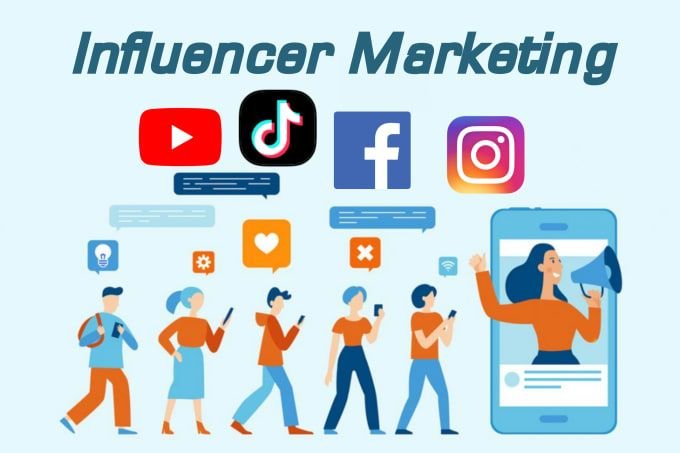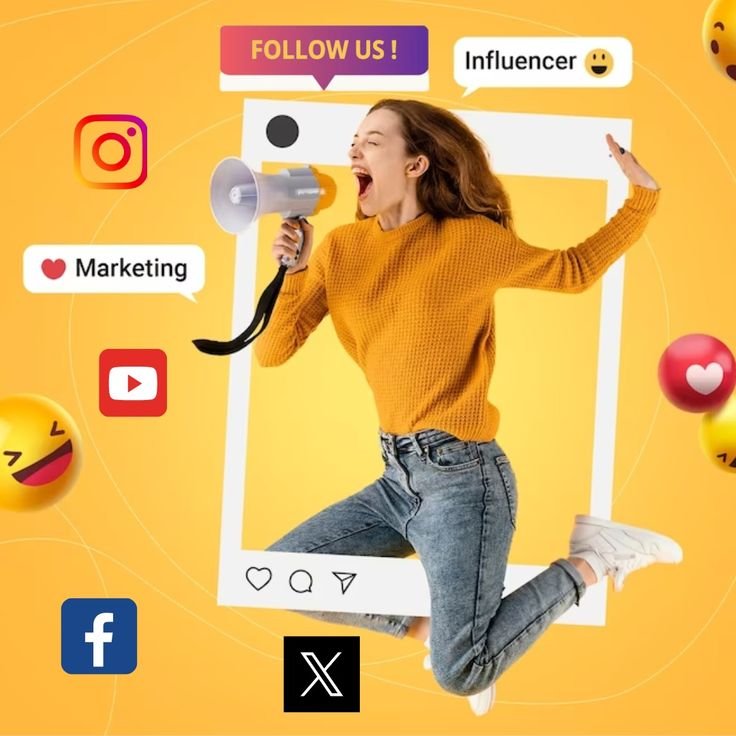Your Attractive Heading the rapidly changing digital marketing landscape of the current age, influencer marketing has become one of the most influential tools in the brand’s marketing arsenal to reach out and talk to its desired customer segment. With more traditional advertising ever-greater in the loss of the consumer’s confidence, next-gen businesses are pointing toward honest, humanized, and community-minded types of communications. Influencer marketing is the here-to-stay, no-trend strategic imperative of the hyper-connected era. By surfing the wave of an influencer’s popularity and following, businesses can launch effective social media marketing campaigns that generate awareness, brand love, and most significantly, quantifiable returns.

Why Influencer Marketing Has Emerged as a Force to Be Reckoned With in Digital Advertising
To understand how influencer marketing impacts individuals, one must understand why it has emerged as such a powerful force in digital marketing. Effectively, influencer marketing is a matter of using the relationship between creators and observers. Contrary to distant or unapproachable celebrities, nano, micro, or macro influencers appear nearer, genuine, and empathetic to the viewers’ issues and problems. They possess messages discovered to be authentic, and they are bound to glance over or glance hastily through their message unconsciously. Their authenticity is what makes their advertising language superior to normal advertising in terms of intruding into user activity or being an advertising buzzword.
Such platforms as LinkedIn, Instagram, YouTube, and TikTok have given creators a content stage on which they have been able to build niche-interest communities—holiday, technology, finance, beauty, education, fitness, etc. These are companies that have an established audience base right at the get-go. Such involvement gives influencer marketing an immense advantage over any other type of marketing platform, and these days, it is integral to every social campaign.
Why Influencer Marketing Works
Influencer marketing is relationship psychology and trust-based. Because people are left with the feeling that someone they admire and respect is using a product or a service, then there is a high chance that they will do the same with it, working. Customer studies have established that consumers will be more willing to trust individuals than brands. This has built an advertising dynamic where the influencer’s voice is more authentic than the company’s.
Apart from trust, influencer marketing also delivers targeting and scalability.
Whether the brand is looking to target millions or a niche market, there is an influencer in both. Micro-influencers who have 10,000 to 100,000 followers will have a higher engagement rate compared to celebrities or mega-influencers. Their audience views them as friends and equals, and as a result, the brand message will be perceived by them as real rather than something of an advertisement. This shareability makes influencer advertising campaigns extremely scalable and versatile to be accommodated within any budget and goal.
Apart from that, influencers also produce quality, natively platformed content from trending and user behavior. Not only that, but it also saves brands’ time and production costs, as well as the authenticity of their content, thereby improving their performance and virality. Influencers’ creative freedom gives them the power to tell stories much more personalized than a scripted brand voice.
Strategic Integration of Influencer Marketing into Campaigns
Influencer marketing alone will not deliver the desired results. Brand and influencer strategies need to meet campaign goals to unlock the maximum potential of influencer marketing. Successful campaigns equate to making real objectives—brand awareness, lead gen, engagement, conversion—and creating the right influencers with data-driven intelligence.
A successful campaign starts with research. One must identify influencers with shared values with the brand, an engaged audience, and good content. Utilize tools such as BuzzSumo, Upfluence, and CreatorIQ, which offer in-depth information, to facilitate comparison of the influencer’s outreach, engagement ratio, audience segmentation, and authenticity score. Statistic-based, it allows for placing the biggest spend on the campaign for the best ROI.
If the influencer is selected well, then the partnership will need to be one of cooperation and not dictatorship. Influencers are at the mercy of the people. Brands do not need to pen every word of copy and visual dialogue themselves. Brands merely need to provide guidance, key messages, and product USPs—then let the influencer get on with it in their own words and style. Then it will be genuine and require the trust of the audience.
The timing of the campaign is important too. Placing influencer content during product launches, holiday promotions, or popular-topic hashtags makes it noticeable and heard. Placing influencer content in paid media—a technically exacting process, as whitelisting—makes content noticed by enormous audiences, with brands able to extend high-performing posts with advanced targeting.

Types of Influencer Campaigns and Their Uses
Awareness Campaigns
- Objective: Maximize brand or product visibility.
- Strategy: Work with macro-influencers or celebrity influencers with high followings.
- Best For: Standalone campaigns to appeal to the masses and build brand awareness at breakneck speed.
Engagement Campaign
- Objective: Drive engagement and audience participation.
- Strategies: Leverage competitions, challenges, or interactive features such as Instagram Stories polls or YouTube Q&A.
- Best Influencers: Micro and nano influencers, with highly engaged niche audiences and cultivate real relationships.
Conversion Campaigns
- Objective: Drive measurable behavior such as purchases, sign-ups, or downloads.
- Execution: Influencers post promo codes, discounts, or temporary bargains.
- Relationship: Long-term partnerships with influencers as permanent brand ambassadors instead of occasional endorsers.
- Control: Requires strict performance monitoring and accurate ROI goals.
Educational Campaign
objective: Explain and share complex concepts to build trust and authority.
- Industries: Extremely effective for finance, technology, and healthcare.
- Influencer Role: Utilize thought leaders, specialists, or business leaders to break down content into bite-sized value content.
- Outcome: Establish credibility instead of brand messaging where it comes naturally.
How to Measure the ROI of Influencer Marketing
Maybe the greatest challenge that marketers face with influencer marketing is what constitutes success. The good news though is that with robust KPIs and technology behind the scenes, influencer campaigns can be as data-driven and ROI-focused as any digital campaign.
Metrics or KPIs are reached, impressions, engagement (comments, likes, shares), click-through rate (CTR), conversions, and cost of acquiring customers (CAC). Utilize codes, UTM parameters, affiliate links, and analytics tools to help attribute conversions and track the customer journey impacted by the campaign.
Other than that, IGC has long-term value. The brands can repurpose the content to leverage for paid media, email marketing, website reviews, or even offline. This increases the campaign time horizon and span, yielding more returns on content investment.
Furthermore, brand sentiment measurement—via social monitoring platforms—can measure some of what the masses are thinking regarding something due to the campaign. Participation and good sentiment within a community can be as valuable as hard conversions, especially for brands that desire to create long-term equity.
The Future of Influencer Marketing in a Creator-Driven Economy
The Future of Influencer Marketing in a Creator-Driven Economy. As the digital world continues to advance, influencer marketing will become even more interactive and trackable. With influencer-led product lines, live shopping, and shoppable videos, it is the next step in this direction.
Brands are also moving towards long-term partnerships rather than campaign-based moments. Influencers are also being thought of less as media assets and more as potential collaborative partners for brands. Co-branded products, joint ventures, and having influencers in the longer-term plan are some of the trends that are making partnerships happen more naturally.
Emergent niche tribes such as pet influencers, green creators, mental health champions, and gamers represent a marketing platform to connect with highly engaged micro-markets. They are not audiences; they are brand-loyal tribes that purchase and generate cultural relevance.
Apart from that, regulatory needs are tightening. Ethical disclosure, transparency, and advertisement standards have now become the center of influencer campaigns. Ethical brand influencer marketing of brands eagerly awaiting regulation to come their way will become more authentic and credible.

Conclusion
Influencer Marketing is Not a Choice—It’s a Competitive Advantage
Influencer marketing is a unique, genuine, and engaging way to connect with customers during an era of fading attention spans and declining faith in corporate messaging. It makes brands more human, triggers imagination, and bridges the space between commercial intent and real participation. But to leverage it, marketers need to go beyond superficial partnerships. They need to embrace data, forge real relationships with influencers, and align campaigns with audience psychology.
The brands that invest in influencer marketing are not a mirage, but a considered pillar of social media strategy, and will thrive in the creator economy. It’s not going viral—it’s building lasting value with voices people trust. In the age of the internet, the influence economy isn’t arriving. It’s already here—and it’s transforming how brands construct.
